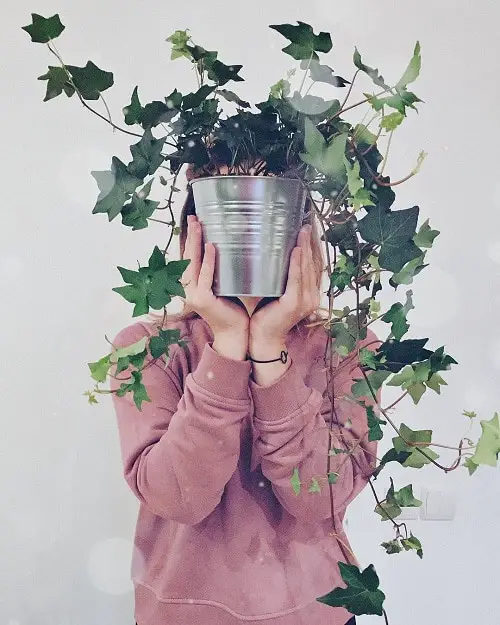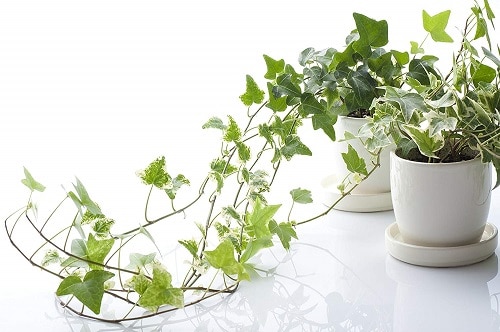If you’re looking for a low care trailing houseplant then growing ivy indoors is the best idea. It’s very forgiving and tolerates low light as well.
Ivy is a low-care plant with a versatile nature, it can be grown as a houseplant, trained to create beautiful topiaries, or kept short as spilling indoor plant with regular pruning. Growing Ivy Indoors can make your home appear lively and more inviting. Plus, this air purifying plant also helps in cleaning the indoor air.
Check out our article on growing Chinese Evergreen Indoors here
Best Ivy Varieties to Grow

The plant comes in many colors and shapes. Here are the best ones:
- Caecilia: Variegated variety with curly, rounded, and frilled foliage.
- Anne Marie: Beautiful specimen with green leaves having creamy margins.
- Curly Locks: Like the name, it has curly leaves and rippled lobes.
- Duckfoot: The leaves are of the shape of a duck’s foot!
- Buttercup: Has green leaves in the shade that turn yellow when exposed to the sun.
- Irish Lace: Star-shaped leaves with fine margins.
Propagating Ivy
Ivy is very easy to propagate–just snip off a stem near the base of the plant and place it in a glass of water. Keep it in a bright location and change the water every few days. In about a month the stem will begin to develop new roots and can be transplanted into a container of potting soil. It will continue to grow and create a new ivy plant.
Choosing a Pot
Selecting a pot depends on the size of the plant. Avoid using a too-large pot as it will keep the soil moist all the time, which can lead to root rot. Re-pot the nursery bought plant into one size bigger pot with sufficient drainage holes.
Requirements for Growing Ivy Indoors
Location
All types of ivy plants need to be in a medium bright location. Eastern exposure is ideal for the plant, but it doesn’t mind northern or western exposure either. Southern exposure is fine too, but don’t make a mistake of placing your ivy plant in the direct sun.
Bright, indirect sunlight is sufficient for its growth but remember, if the plant is not in a location where it receives enough light, it will become leggy.
Ivy, with variegated leaves, will lose the color variations in absence of light. Also, keep the plant away from drafts caused by an exterior door or air vent. If it is placed by a window, be sure the leaves do not touch the windowpane.
Soil
The plant adapts to any type of soil, thanks to its invasive nature, which is why the regular potting mix you use for other houseplants should be fine. You can make your own soilless medium as well with the help of this tutorial.
Watering
While English ivy can tolerate moist and dry soil both, it’s better to keep it on a balanced side. Always allow the soil to dry out slightly between watering spells. When the topsoil (1/2-1 inch depth) is dry to touch, it’s time to water the ivy plant again. You can also mist the foliage with a fine sprayer.
Temperature & Humidity
Compare to other tropical houseplants, English ivy prefers cool rooms and stays happy in the temperature range of 50-75 F (10-24 C). Avoid exposing it to the temperature above 90 F (33 C) as it can cause poor growth and death of the plant.
Besides cool indoor temperature, ivy vine loves high humidity. But it can live easily in normal humidity levels at home. What’s also important to note is that the lack of humidity and dry air attracts pests like spider mites.
How to Care for Ivy

Fertilizer
To make the plant healthier, apply nitrogen-rich liquid fertilizer, alternatively, you can also go for a balanced 20-20-20 blend. Feed your indoor ivy once a month during the growing season. Apply fertilizer from early spring and continue monthly feedings until late fall.
- Avoid fertilizing in winter when the plant stops the growth.
- If you live in a frost-free climate, then you can fertilize the plant in winters.
- Don’t fertilize in summer, if this season is hot in your region and your ivy plant ceases to grow.
Keeping It Clean
All houseplants collect dust and benefit from an occasional washing. If the plant is small, place it in the sink or shower and allow tepid water to gently run on it for 2-3 minutes to wash away dust. Let the plant drain thoroughly before placing it back to the position.
Ivy plants that have been allowed to create long vines will need to be hand-washed. Dip a clean, soft cloth in tepid water, and gently wipe leaves to remove dust. Washing ivy will keep the leaf pores un-clogged so it can efficiently purify the air by removing odors and toxins.
Pruning
While growing ivy indoors, the vine may become leggy over time. Snipping or pinching back the excess growth will make it look more appealing. Also, if you wish to keep it small, you may need to trim it regularly to check the growth.
Re-Potting
You’ll have to re-pot the plant when it’ll become root-bound and top-heavy or when the plant starts to dry out frequently. The new pot should not be more than 1 or 2 inches in diameter than the older one.
If you don’t wish to re-pot the plant, remove the plant from the container and reduce the size of its rootball by removing thin, fine roots carefully, and plant it again in the same container.
Pests & Diseases
Be careful of spider mites, aphids, and mealybugs. To get rid of mites, learn these tricks. For the remaining two, either handpick them manually or spray with insecticidal soap or pesticide.
If the plant is manageable in size, you can also dunk its stems in water to wash those pesky pests.
In diseases, you don’t need to worry about much except for root rot. Avoid overwatering to save your plant from it. Also, fungal leaf spots may occur and you can take care of them by using a copper-based fungicidal spray.




I bought my english ivy baltic plant 2 weeks ago from Amazon. It was beautiful and perky, now it is limp and small leaves underneath are dying. I tried watering the plant more and even misting but I am afraid it is dying. Is this possibly just an adjustment period, it looks and feels very limp. I need advice as to what I should try. It is in a west window so it gets moderate light. Can anyone give me advice as to what I should try next.
Feel the soil. If it is wet, you may be watering it too much. Let it dry out, but it sounds as if it may be too late to save it. Sorry!